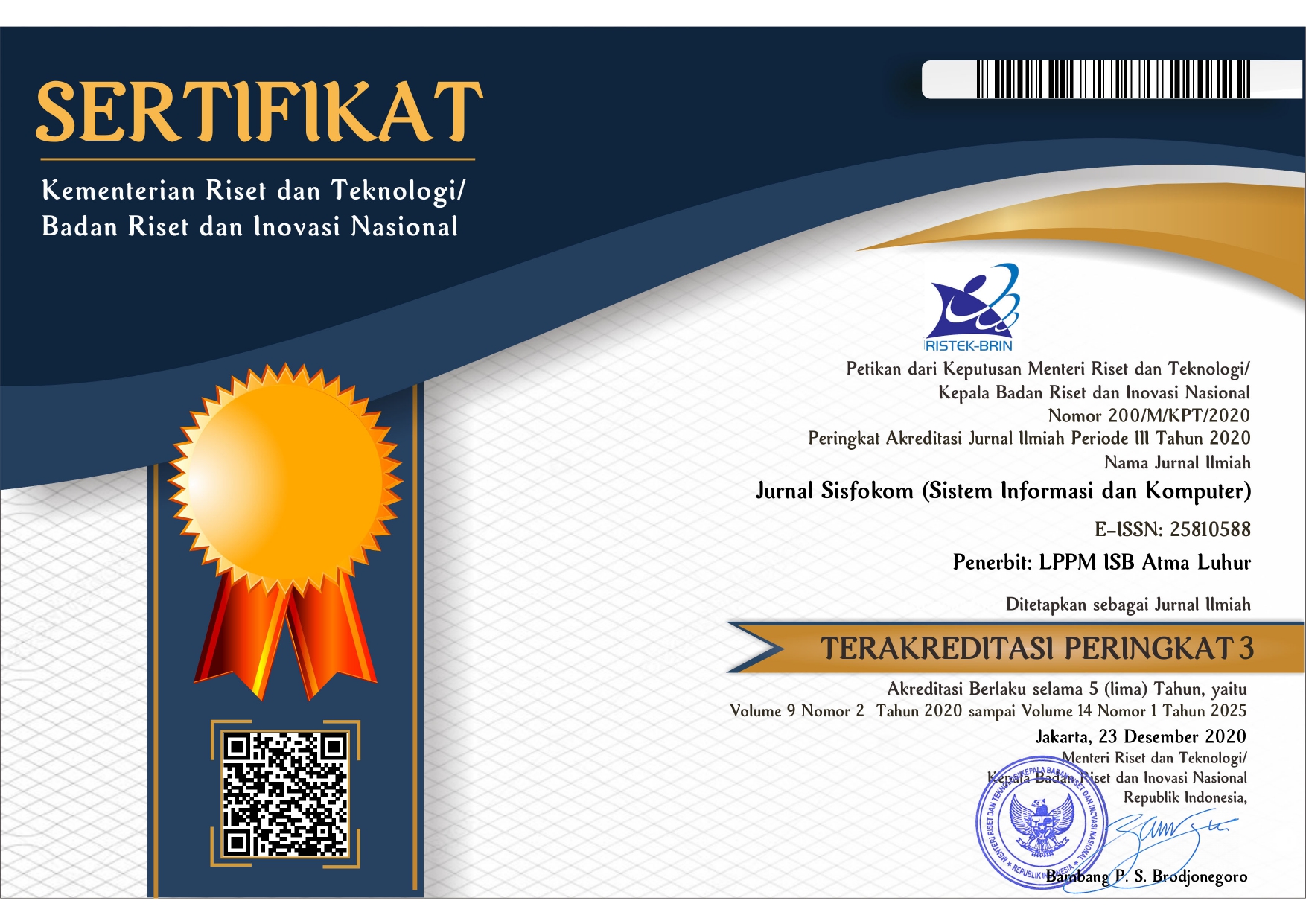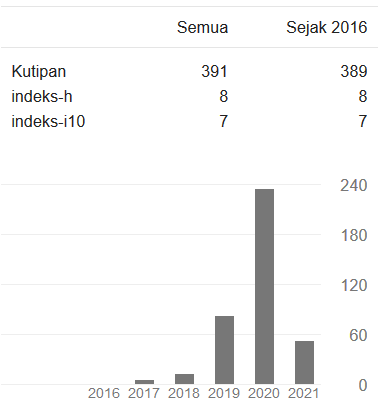Implementation of an IoT-based Threshold Method for a Food Hazardous Substance Detection Tool
DOI:
https://doi.org/10.32736/sisfokom.v14i3.2397Keywords:
Internet of Things, HCHO Sensor, TCS3200 Sensor, Threshold, Hazardous SubstancesAbstract
Food safety is a critical issue that has a direct impact on public health. Illegal addition of hazardous substances such as rhodamine B, melachite green, methanyl yellow, formalin, borax, and sodium hypochlorite are still commonly found in food products sold in the market. This research project aims to develop a tool for detecting hazardous substances in Internet of Things (IoT) based foods using a threshold method that refers to BPOM regulations. The threshold method refers to BPOM regulations. This system integrates two sensors: The TCS3200 sensor is used for RGB color analysis, and the HCHO sensor detects volatile compounds detecting volatile compounds. Test results show that this tool achieves 96.67% accuracy in identifying hazardous substances without producing false positives. The novelty of this research lies in combining both sensors into one system with real-time notification via Telegram. This research is novel because it combines both sensors into one system with real-time notifications via Telegram. It combines both sensors into a single system with real-time notifications via Telegram and ThingSpeak.References
Menteri Kesehatan Republik Indonesia, Peraturan Menteri Kesehatan Republik Indonesia Nomor : 722/Menkes/Per/Ix/88 Tentang Bahan Tambahan Makanan, Vol. 21, No. 4. 1985, Hal. 162.
Badan Pengawasan Obat Dan Makanan, Peraturan Badan Pengawas Obat Dan Makanan RI Nomor 37 Tahun 2013. 2013, Hal. 1–18.
R. Adolph, “Mengidentifikasi Methanyl Yellow Pada Nasi Kuning Yang Di Jual Di Tiga Pasar Kelurahan Kunciran Indah,” Hal. 1–23, 2024.
I. Thristy, A. E. Damayanty, Dan N. S. Nuralita, “Dampak Bahan Kimia Berbahaya Dalam Makanan Terhadap Kesehatan,” J. Implementa Husada, Vol. 3, No. 3, Hal. 121–126, 2022, Doi: 10.30596/Jih.V3i3.11846.
T. Rosa Dan S. L. Rahmi, “Analisis Kandungan Formalin Dan Boraks Dalam Tahu Putih Yang Di Jual Di Pasar Tradisional Kota Jambi,” Hal. 1–6, 2025.
R. Prayogo, “Alat Pendeteksi Formalin Pada Makanan Tahu Dengan Monitoring Telegram,” Electr. J. Rekayasa Dan Teknol. Elektro, Vol. 18, No. 1, Hal. 56–61, 2024, Doi: 10.23960/Elc.V18n1.2492.
M. Syukri Dan R. Mukhaiyar, “Alat Pendeteksi Formalin Pada Makanan Menggunakan Iot,” Ranah Res. J. Multidiscip. Res. Dev., Vol. 3, No. 2, Hal. 80–87, 2021, Doi: 10.38035/Rrj.V3i2.374.
R. R. Edy Dan A. Nurdin, “Rancang Bangun Alat Pendeteksi Bahan Kimia Pada Makanan Berbasis Internet Of Things (Iot),” Vol. 6, No. 2, Hal. 1211–1221, 2024, Doi: 10.47065/Bits.V6i2.5575.
I. P. A. W. Widyatmika, N. P. A. W. Indrawati, I. W. W. A. Prastya, I. K. Darminta, I. G. N. Sangka, Dan A. A. N. G. Sapteka, “Perbandingan Kinerja Arduino Uno Dan ESP32 Terhadap Pengukuran Arus Dan Tegangan,” J. Otomasi Kontrol Dan Instrumentasi, Vol. 13, No. 1, Hal. 35–47, 2021, Doi: 10.5614/Joki.2021.13.1.4.
S. Widayati Dan Ire Puspa Wardhani, “Analisa Segmentasi Warna Hsv Pada Citra Video Dengan Metode Threshold,” Semin. Nas. Teknol. Inf. Dan Komun. STI&K, Vol. 4, No. 1, Hal. 339–345, 2020.
Peraturan BPOM No 32 Tahun 2019 Tentang Persyaratan Keamanan Dan Mutu Obat Tradisional, Badan Pengawas Obat Dan Makanan Republik Indonesia, Vol. 11. 2021, Hal. 1–16.
F. A. Siti, “Rancang Bangun Alat Pendeteksi Bahan Kimia Pada Makanan Berbasis Internet Of Things (IOT ) Dengan Aplikasi Android,” 2022.
H. P. Darmayanti, N. Fitriani, D. Setiani, S. Nurfadilah, Dan I. A. D. Astuti, “Rancang Bangun Smart Nose Pendeteksi Zat Pengawet Berbahaya Pada Ikan,” Schrodinger J. Ilm. Mhs. Pendidik. Fis., Vol. 2, No. 1, Hal. 32–37, 2021, Doi: 10.30998/Sch.V2i1.4289.
K. Elgazzar Et Al., “Revisiting The Internet Of Things: New Trends, Opportunities And Grand Challenges,” Front. Internet Things, Vol. 1, Hal. 1–20, 2022, Doi: 10.3389/Friot.2022.1073780.
E. N. Dwi Hartati, Desy Kurniawati, “Optimasi Penyerapan Malachite Green Menggunakan Biosorben Kulit Matoa (Pometia Pinnata) Dengan Metode Batch,” Periodic, Vol. 12, No. 2, Hal. 50, 2023, Doi: 10.24036/Periodic.V12i2.118255.
Downloads
Published
Issue
Section
License
Copyright (c) 2025 Threa Malinda, Irma Salamah, Nurhajar Anugraha

This work is licensed under a Creative Commons Attribution 4.0 International License.
The copyright of the article that accepted for publication shall be assigned to Jurnal Sisfokom (Sistem Informasi dan Komputer) and LPPM ISB Atma Luhur as the publisher of the journal. Copyright includes the right to reproduce and deliver the article in all form and media, including reprints, photographs, microfilms, and any other similar reproductions, as well as translations.
Jurnal Sisfokom (Sistem Informasi dan Komputer), LPPM ISB Atma Luhur, and the Editors make every effort to ensure that no wrong or misleading data, opinions or statements be published in the journal. In any way, the contents of the articles and advertisements published in Jurnal Sisfokom (Sistem Informasi dan Komputer) are the sole and exclusive responsibility of their respective authors.
Jurnal Sisfokom (Sistem Informasi dan Komputer) has full publishing rights to the published articles. Authors are allowed to distribute articles that have been published by sharing the link or DOI of the article. Authors are allowed to use their articles for legal purposes deemed necessary without the written permission of the journal with the initial publication notification from the Jurnal Sisfokom (Sistem Informasi dan Komputer).
The Copyright Transfer Form can be downloaded [Copyright Transfer Form Jurnal Sisfokom (Sistem Informasi dan Komputer).
This agreement is to be signed by at least one of the authors who have obtained the assent of the co-author(s). After submission of this agreement signed by the corresponding author, changes of authorship or in the order of the authors listed will not be accepted. The copyright form should be signed originally, and send it to the Editorial in the form of scanned document to sisfokom@atmaluhur.ac.id.









